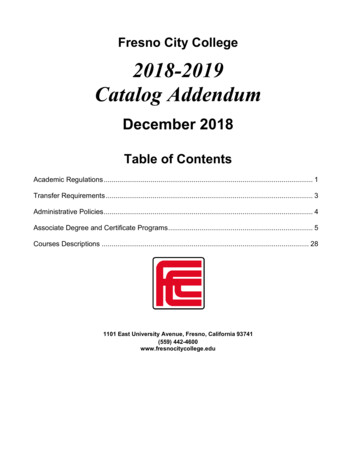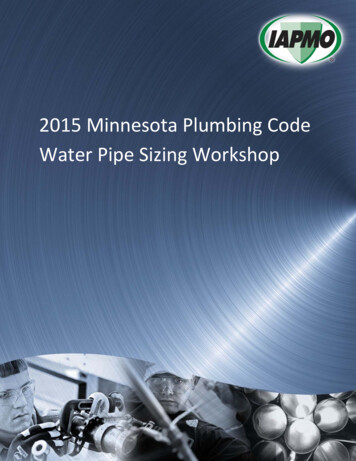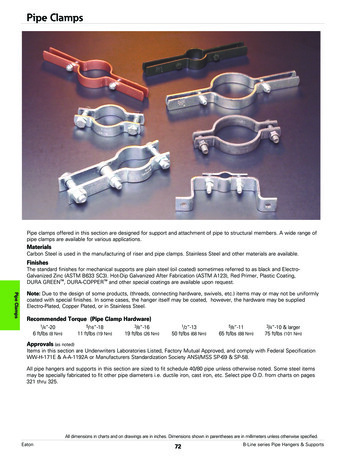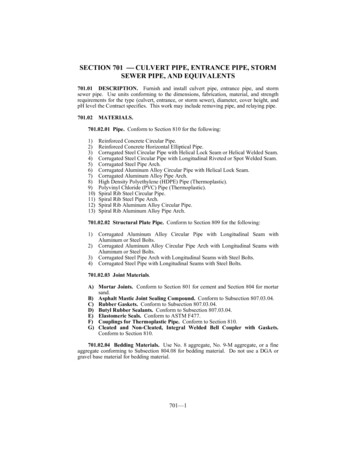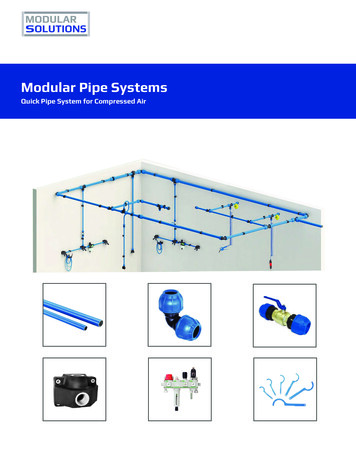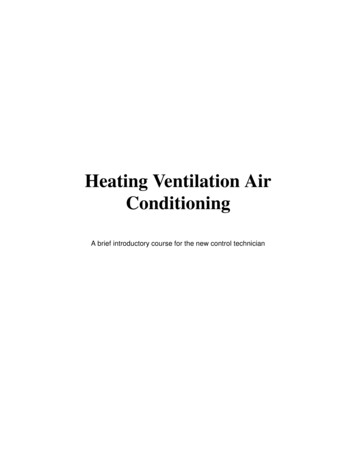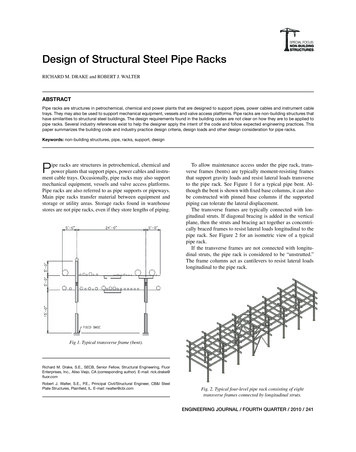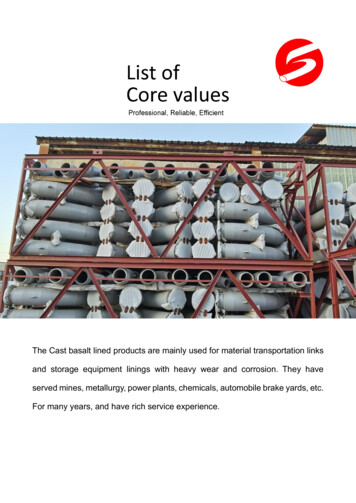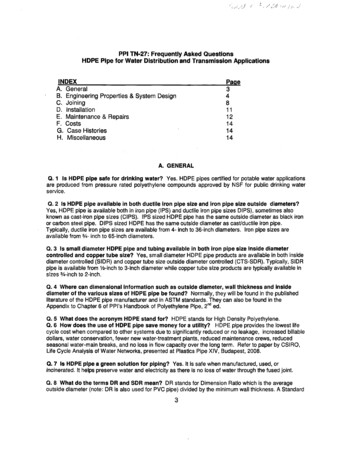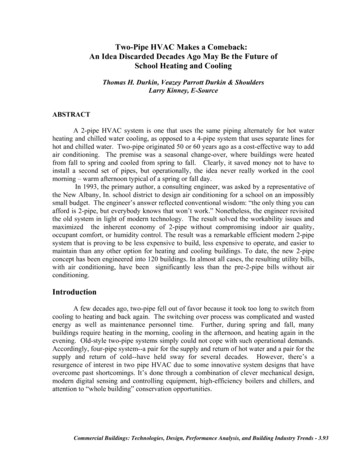
Transcription
Two-Pipe HVAC Makes a Comeback:An Idea Discarded Decades Ago May Be the Future ofSchool Heating and CoolingThomas H. Durkin, Veazey Parrott Durkin & ShouldersLarry Kinney, E-SourceABSTRACTA 2-pipe HVAC system is one that uses the same piping alternately for hot waterheating and chilled water cooling, as opposed to a 4-pipe system that uses separate lines forhot and chilled water. Two-pipe originated 50 or 60 years ago as a cost-effective way to addair conditioning. The premise was a seasonal change-over, where buildings were heatedfrom fall to spring and cooled from spring to fall. Clearly, it saved money not to have toinstall a second set of pipes, but operationally, the idea never really worked in the coolmorning – warm afternoon typical of a spring or fall day.In 1993, the primary author, a consulting engineer, was asked by a representative ofthe New Albany, In. school district to design air conditioning for a school on an impossiblysmall budget. The engineer’s answer reflected conventional wisdom: “the only thing you canafford is 2-pipe, but everybody knows that won’t work.” Nonetheless, the engineer revisitedthe old system in light of modern technology. The result solved the workability issues andmaximized the inherent economy of 2-pipe without compromising indoor air quality,occupant comfort, or humidity control. The result was a remarkable efficient modern 2-pipesystem that is proving to be less expensive to build, less expensive to operate, and easier tomaintain than any other option for heating and cooling buildings. To date, the new 2-pipeconcept has been engineered into 120 buildings. In almost all cases, the resulting utility bills,with air conditioning, have been significantly less than the pre-2-pipe bills without airconditioning.IntroductionA few decades ago, two-pipe fell out of favor because it took too long to switch fromcooling to heating and back again. The switching over process was complicated and wastedenergy as well as maintenance personnel time. Further, during spring and fall, manybuildings require heating in the morning, cooling in the afternoon, and heating again in theevening. Old-style two-pipe systems simply could not cope with such operational demands.Accordingly, four-pipe system--a pair for the supply and return of hot water and a pair for thesupply and return of cold--have held sway for several decades. However, there’s aresurgence of interest in two pipe HVAC due to some innovative system designs that haveovercome past shortcomings. It’s done through a combination of clever mechanical design,modern digital sensing and controlling equipment, high-efficiency boilers and chillers, andattention to “whole building” conservation opportunities.Commercial Buildings: Technologies, Design, Performance Analysis, and Building Industry Trends - 3.93
Retrofit School WorkIn thinking through how to design a satisfactory two-pipe system, it was decided rightaway that the old way of changing over from heating to cooling in the spring and back againin the fall would leave a lot of people unhappy. Accordingly, along with keeping costs low,the ability to change over daily became a major design objective. Thus, the key questions thatneeded to be answered in the design process to make two-pipe changeover viable were:x x x How quickly can changeover be accomplished? The old systems would take about aday of constant operator attention.How complicated must the resulting system be? The old systems had multiple valves,pumps, drains, etc.When (as a function of room temperatures and weather) should the change-of-modesprocess be initiated? The old systems changed over once a season.As the initial two-pipe design evolved, addressing these design issues developed as follows:(1)(2)(3)Changeover can be accomplished with very little loss of energy in 20 minutes with nohuman intervention whatever.The system is remarkably simple from the mechanical point of view so that a singlevalve controlled by a microprocessor switches from heating to cooling and backagain. Genuine complexity is in the software which is nonetheless simple from theuser’s point of view; andThe change from morning heating to afternoon cooling should be initiated when theoutside air temperature is rising above 60 F and all of the zones are comfortably warm(all local thermostats are satisfied).Evansville-Vanderburgh School District RetrofitInitial success with the New Albany, Indiana school district mentioned in the abstractled to other opportunities, the largest of which was the Evansville-Vanderburgh SchoolCorporation in southern Indiana. The school district has 35 school buildings, twenty ofwhich were not air-conditioned. This lack of cooling was identified as a major shortcomingof the educational environment in this southern Indiana climate whose weather routinelyincludes uncomfortably high temperatures and humidity.All 20 schools had air conditioning installed for the first time and each also hadlighting retrofits. As shown in Figure 1, the before-retrofit cost per square foot for energyranged from 0.51 to 0.90 and averaged 0.66. After-retrofit cost per square foot for energyranged from 0.38 to 0.77 and averaged 0.54, an overall savings of 0.12 per square footfor all 20 schools, or 18.2 percent. Fifteen of the 20 schools retrofitted experienced first yearsavings, the best of which was 0.28 per square foot.3.94
Figure 1. Energy Savings in Evansville SchoolsSource: Engineered SystemsIn year three of the retrofit, the 20 buildings in the project saved 3,780 megawatthours of electricity or 429,214. Year three natural gas savings were 1,011,066 therms or 441,780, for a total annual dollar savings to the school district of 871,000.How It Is DoneFour pipe systems were designed to overcome the shortcomings presumed inherent intwo pipe systems. Designing around those shortcomings required some innovativeengineering. “Seek simplicity—but distrust it,” an aphorism from the philosopher andmathematician Alfred North Whitehead, could be taken as the first principle of modern 2pipe design. ASHRAE volumes of the 1970s and 1980s included many pages on two-pipedesigns, but they were hopelessly complicated. The systems had primary and secondarypumping, many valves to control flow and isolate parts of the system, and a number ofexpansion tanks. All of this was eliminated for cost savings, ease of operation, andsimplicity. The result is a system that requires only one valve to change from heating tocooling. There are no blending valves, no secondary pumps, and no extra expansion tanks.Commercial Buildings: Technologies, Design, Performance Analysis, and Building Industry Trends - 3.95
A schematic of a generic system is shown in Figure 2. The three-way valveimmediately above the chiller at the bottom of the diagram switches the system’s mode ofoperation. In the heating mode, the return line from the room terminal units (typically fancoils or unit ventilators) bypasses the chiller and goes to a header that feeds the boilers. Whenthe main three-way valve is moved to the cooling position, return water is directed throughthe chiller. The “heat trap” where the boiler and chiller outlets converge, is an example ofthe design ingenuity. ASHRAE handbooks show anywhere from two to six motorizedchange-over valves. The heat trap allows this design to use only one valve and nature – thedifferential densities of hot and cold water – to isolate the boiler and chiller circuits with nomoving parts and no added cost.As shown in Figure 3, the motor-driven changeover valve is automatically actuatedby a command from the operating software whose control algorithms account for outdoortemperature, temperatures in every zone of the system, time of day, and day of the week.The heat trap is shown in Figure 4. When there is no flow in the heating loop, thewater at the top of the heat trap is hotter (less dense) than the water at the bottom of the loop.Accordingly, higher density cold water from the chiller will not come through the heat trap,thereby protecting the boilers.By keeping things as simple as possible, valves are minimized, so the resistance toflow through the system is low. As a result, pumping power can be quite low as well.Keeping pumping power low saves on both front end costs and overall energy costs. It’sroutine for pumps for HVAC systems to account for five percent or even more of totalHVAC system energy. A properly designed two-pipe system will use half that. Since thecoils and piping are sized for the larger flows required for cooling, when the system switchesto heating (about 75% of the operating hours), pump laws dictate that delivering two thirdsthe flow only takes 30% of the pump power. Of course, high efficiency motors are used(Figure 5). This two-motor strategy also facilitates maintenance, as the idle pump is alwaysavailable as a stand-by.3.96
Figure 2. Two-Pipe System DiagramCommercial Buildings: Technologies, Design, Performance Analysis, and Building Industry Trends - 3.97
Figure 3. Changeover ValveFigure 4. Heat TrapSource: Jeff Bowers photo, Veazey, Parrott, Durkin & ShouldersFigure 5. Circulation Pumps at a 50,000 SFElementary School. The Big Pump (10 Hp.) isfor Cooling, the Little Pump (3 Hp.) is forHeating.Source: Greg Stephens photo, Veazey, Parrott, Durkin & ShouldersEfficient boilers. Another ingredient that makes the new two-pipe approach especiallyefficient is the use of low mass condensing boilers with thermal efficiencies of 96%, versus80-82% for conventional boilers. The real operational savings are proving to be much morethat the incremental difference between 80 and 96%. By carefully designing the piping,boiler start-up losses can be eliminated, and by designing the balance of the heating systemfor low temperature water, parasitic piping losses can be eliminated. A 2-pipe boiler plantoperates at 130F on the coldest day of the year, compared to 180 or 200F for conventionalboilers. The 130F is significant because it means that the heat of condensation of the watervapor in the flue gasses is recouped continually. Conventional boilers must operate at3.98
considerably higher temperatures since their metallurgy cannot tolerate temperatures thatlow. Some steam-to-hydronic 2-pipe conversions have resulted in a gas savings in the 70%range, and 180F hot water-to-2-pipe conversions have generated savings in the 40-50%range. (Imagine the energy implications on a national basis if all of our public buildingswere being heated with one half or one third of the energy. Imagine the national impact onozone levels and green house gasses.)The pair of million Btu per hour condensing boilers shown in Figure 6 can bethrottled down to 67,000 Btu per hour (16 to 1 turndown). Combustion air is introducedthrough the PVC pipes on the right. The stainless steel flue pipe on the left is never so hotthat it would burn a hand.Figure 6. Pair of Condensing AERCO BoilersSource: Greg Stephens photo, Veazey, Parrott, Durkin & ShouldersAs shown in Figure 7, efficiencies at part load exceed full load efficiencies, theinverse of the case with most other boilers. Note that lower return water temperatures alsoresult in higher efficiency. When throttled back to 25 percent of full load input and with areturn water temperature of 110 F, this boiler achieves 96 percent efficiency.Commercial Buildings: Technologies, Design, Performance Analysis, and Building Industry Trends - 3.99
Figure 7. Efficiency Curves for the Benchmark 2.0 AERCO BoilerSource: AERCODeliveryIn 1917, Herman Nelson invented the first unit ventilator. It consisted in little morethan a hole in the wall, a steam radiator, and a fan, but heated fresh air was successfullybrought into a conditioned space. Modern versions of unit ventilators in each classroom of aschool are key elements in modern two pipe system designs. They regulate temperature,ventilation rates, and (to a degree) humidity. Instead of inserting valves to regulate flowfrom the boiler or chiller through the heat exchangers in the ventilator, the flow of water isconstant—and the pressure drops in the system are low. Temperature is controlled by varyingthe volume of air that flows across the heat exchanger by manipulating dampers in each unitventilator. A second damper regulates the volume of outside air introduced into the airstream. Accordingly, with this “face and bypass” damper system, air introduced into aconditioned space is a combination of return and fresh air, some portion of which (from 0 to100 percent, depending on the difference in the thermostatic setting and instantaneous roomtemperature) passes through the “coil,” a water-to-air heat exchanger. Additionally, the fanspeed in the unit ventilators can be controlled step wise: low, medium, and high. See Figure8.Unit Ventilators with Face and Bypass ControlsFace and bypass damper systems in unit ventilators have a number of advantages overunit ventilators that regulate space conditioning energy using valve control By their nature,control valves introduce resistance to flow which is ultimately reflected in a higher totalpressure head the pumping motors much overcome. So motors must be larger and electricityconsumption is higher. More serious, valve control units are at risk of freezing under winterconditions when ventilation air is brought in during periods when the thermostat is satisfied.Designs to avoid the problem exist, but they add costs and complications that riskmaintenance problems.3.100
Figure 8. Unit Ventilator with Face and Bypass ControlsSource: Jeff Bowers photos, Veazey, Parrott, Durkin & ShouldersWith a valve control unit, the control valve regulates the flow of warm water (in thewinter) or chilled water (in the summer) to the heat exchanger while all of the outside andreturn air is pulled through the heat exchanger at a volume that depends on the fan speed.With the face and bypass system shown in Figure 9, the flow of water through the heatexchanger is constant, but the amount of return and outside air that passes through the heatexchanger is varied with the bypass damper.Figure 9. Unit Ventilators with Face and Bypass ControlSource: Veazey, Parrott, Durkin & Shoulders, AAF Herman NelsonDealing with humidity. Indoor air quality and humidity control are two frequently citedreasons why 2-pipe fell out of favor. On high humidity days in the cooling season, it isvirtually impossible to both maintain ventilation rates at 15 cfm per occupant and humidityCommercial Buildings: Technologies, Design, Performance Analysis, and Building Industry Trends - 3.101
levels below 60 percent, both mandates of ASHRAE Standard 62, Ventilation for AcceptableIndoor Air Quality. Yet through careful manipulation of face and bypass dampers andmodulation of fan speed, ventilation requirements can be met while keeping humidity levelsin check. The real trick is to maintain the coil (heat exchanger) well below dewpoint anddirect all of the outside air through the coil. The return air is already conditioned, so muchof that can be bypassed around the coil on its way through the fan and into the classroom.Running chilled water at full volume through the coil aids the dehumidification function,whereas modulating its volume makes it less effective.This was a key point shown in a recent article in Heating/Piping/AirConditioning, wherecomparisons are made in the performance of unit ventilators using (1) a valve control system,and (2) a face and bypass controlled system (Durkin 1999). These were the conditionsassumed for the analysis:x x x x x Unit ventilator with a 1200 cfm fan4.5 tons (54,000 Btu/hr) of cooling load450 cfm outside air (15 cfm per person for 30 occupants)75 degree room temperature.Outside air 95 F dry bulb, 78 F wet bulb (48% relative humidity)Under this very typical circumstance, the valve control system worked adequately at fullload, but was unable to maintain part load relative humidity below the 60%RH code limit(this one part load example was 68%). Whereas the face and bypass system maintains 56%RH.ControlsEnergy Management Systems (EMS) are integrated into each new two pipe HVACdesigns. In fact, digital technology is a necessary condition for these systems to work.Twenty years ago, the technology did not exist to allow for controlling equipment in theboiler room and local environments well enough to ensure comfort and efficiency, let aloneswitching over modes without any human intervention All that has changed.Now, each installation has electronic equipment installed that allows for supervisingtemperatures, set points, flow rates, equipment status, and the like from computers installedat each installation or remotely. The facilities personnel can monitor every sensor in everyschool in a school district from the convenience of his office. The software provides anelectronic plan view of each school, shows readouts of sensors, and signals variations fromsetpoints when readings are beyond a specified tolerance. Since local building personnel canmonitor the data on their schools at the same time, this facilitates the informed discussionsand expeditious resolution of problems.Buildings are set up to require a minimum of human interventions during routineoperations. The EMS has calendar information stored so that temperatures and ventilationrates are varied to meet occupancy requirements or, during unoccupied periods, to minimizeenergy consumption. Supply temperatures from boilers and chillers are varied to maximizeefficiency as a function of outdoor dry bulb and wet bulb temperatures as well ascircumstances of occupancy. In the case of classrooms in schools, teachers have thermostats3.102
they can control to ensure local comfort, but typically, the range of options covers only sixdegrees F.Special Case RetrofitMost institutional buildings retrofitted for energy efficiency and air conditioningalready have a pair of pipes that run from the boiler room to local zones. Although these areusually replaced, the new insulated piping can routinely be routed through chaseways madefor the old piping, so major surgery is avoided. Of course, this is another reason two pipesystems are less expensive to install in retrofit jobs than are four pipe systems; thejackhammer bill is lower. However Public School Number 93 in Indianapolis presentedspecial difficulties--it was an all electric building without air conditioning. Accordingly, ithad neither dedicated chaseways for piping nor a boiler room. Although its brickconstruction has resisted the wear of a half a century of Indianapolis winters, its poorlyinsulated walls coupled with electric resistance heating made for large heating bills. Ratherthan building a new room for the boilers, a janitor’s closet now houses a pair of millionBtu/hour condensing boilers, circulation pumps, water treatment equipment, controlelectronics, and sundry plumbing. (The small foot print of a 2-pipe boiler room is anotherfirst cost saving feature). Energy cost savings from converting this building from electricresistance heating to a two-pipe HVAC system that includes cooling are not quite asimpressive as some other schools, primarily because the old system was bringing in virtuallyno fresh air.Two Pipe Operators’ GroupThe hundred-twentieth two-pipe job was designed in the spring of 2002, so there’s agrowing number of maintenance people who are gaining practical wisdom in operating twopipe systems. The process of sharing this wisdom, training new people, and dealing withquestions as they arise is enhanced by a unique organization called the “T-POG”—the TwoPipe Operators’ Group. As often as not, those who operate and maintain energy systems inschools don’t have much formal education in HVAC theory or practice. Accordingly, it’sespecially useful to get people together to talk about how systems are supposed to work, tellthem about new technologies in the offing, and help them deal with problems that crop up.The idea has taken hold and T-POG members are proud of their special status. They have aweb site (www.vpdsweb.com/vpdseng/) that prominently displays the group’s motto: “Noneof us are as smart as all of us.” The T-POG group has a major event every six months. It’s afull-day meeting where workshops are offered on a variety of topics relevant to the care andfeeding of two pipe HVAC systems. A variety of new products and ideas are also introducedat these meetings. A camaraderie has built up among group members, who are fond ofpointing out the features of the two-pipe systems they operate that make them outperform thesystems operated by colleagues. Such friendly competition is to the benefit of all.New ConstructionMost two-pipe work undertaken to date has involved retrofitting existing buildings,typically institutional structures. Although retrofitting work often demands more creativityCommercial Buildings: Technologies, Design, Performance Analysis, and Building Industry Trends - 3.103
than does new building design work, is a similar approach to new construction likely to be assuccessful? In the case of schools, the answer is clearly yes. The key reason is that there isa tradition of unit ventilators in 900 square foot classrooms which function very effectively inan economizer mode (access to outside air for free cooling, since schools are generally heatpositive down to about 35F outside air temperature). Running energy in the form of water ina closed loop from a chiller or a boiler to the zones where it is needed has a number ofadvantages. The horsepower to deliver the energy is many times less than is necessary withair ducted systems, which require a good deal of fan power even with variable air volumedesigns. Pipes take up much less space than ducts, and the extra volume can make asubstantial difference in controlling building cost. The principal author’s firm hasfunctioned as the design/builder for two new buildings in which they have installed two pipeHVAC systems, both middle schools of about 90,000 square feet. Savings in first costs dueto going with two-pipe was from 400,000 to 500,000 for each of these new buildings,whose total cost for construction was about 9 million. Energy savings are on the order of 15cents per square foot per year. Of course, in some modern buildings, there is a need forsimultaneously cooling in some places and heating in others. This can be controlled to alarge extent with overhangs and specularly selective glazings for sun control, plus air sealingand adequate insulation. However, when certain areas with a concentration of computers oroffice machinery require cooling for much of the year, it may be necessary to use a separatesmall four-pipe system or simply a small dedicated chiller. The trick is to accommodatespecial cases when they arise, while maintaining a high level of energy efficiency consistentwith intelligent controls and overall simplicity of design. In all buildings examined so far,the two-pipe system approach works quite well for most zones throughout the year.Sources of Efficiencyx x x x x x x x Condensing boilers - operating 100% of the time in the condensing mode. Schematicarrangement of boilers eliminates start-up or stand-by losses. Space temperaturefeedback for supply water reset, both up and down.Aggressive scheduling – only operate the system when the building is occupied, andonly operate the portions of the building that are occupied.Managing outside air – use “normal” and “event” modes for large assembly spaces(gyms, auditoriums and cafeterias); CO2 sensors; match outside air to actualoccupancy.Right-sizing boilers and chillers.Minimizing pump and fan power.Dehumidifying without reheat.Avoiding simultaneously heating and coolingImplementing a good lighting design – with a 50 footcandle target for classrooms.Two Pipe: Design PrinciplesBy way of summarizing key elements of the new approach to designing two pipesystems, it is useful to list some rules of thumb:3.104
x x x x x x x x Keep all elements of the design as simple as possible consistent with maintaininghealth, safety, comfort, good energy performance, and long-term cost effectiveness.Well placed sensors in conjunction with smart controls manipulated viamathematically sophisticated algorithms can often enable simplicity of hardware.Straightforward hardware is less expensive and easier to understand, install, andmaintain.Study the building as a whole, quantifying the space conditioning needs and patternsof energy use as a function of each zone. Use this intelligence information to adoptan overall energy efficiency strategy before specifying equipment for the HVACsystem. For school retrofits, it’s usually quite cost effective to replace old T-12lighting fixtures with T-8 or T-5-based fixtures with electronic ballasts. This strategyboth directly cuts electric energy use and lightens the air conditioning load.Design the two pipe HVAC system to meet the cooling load. This affects the size ofthe chiller, the size of the unit ventilators, and the rate of pumping chilled water(which determines the size of the circulation pump.) After the cooling load is met,the heating system design can be completed by specifying a boiler combination thatwill supply adequate heating on the design day.Choose equipment with a view to good performance vis-à-vis other elements of thesystem, energy efficiency, maintainability, long life, and low cost (in that order). Thebig ticket key system elements are boilers, chillers, and unit ventilators. Highlyefficient, low volume condensing boilers that can be modulated down to 6 percent oftheir full rated output with no loss in efficiency are a real bargain. Chillers with“fuzzy logic” that allows flexibility in operating conditions (including acceptingreturn water at 100 F for brief periods) are desirable. Unit ventilators with directdigital control over face and bypass settings and fan speeds are key to maintainingindoor air quality and comfort efficiently.Minimize pipe losses by using large diameter, well insulated pipe, keeping runs asstraight as practical, and eliminating as many valves as possible. This saves money,pumping power, and maintenance headaches.Install a reliable energy management system (EMS). This plays many roles, frommodulating boiler temperatures as an inverse function of outside air temperatures tomaximizing system efficiency. An EMS is necessary for monitoring and displayingtemperatures and flow rates throughout the system as a part of a continuouscommissioning process. The system must be capable of automatically controllingthe switchover from heating to cooling (and back again), setting flags when values areout of tolerance, and displaying information that enhances the effectiveness of bothroutine and special maintenance work.Set up the new system and commission it with attention to detail. In addition tohardware, sensors, and control software, the commission process needs to include ahuman element. All users—janitors, teachers, maintenance people, and principals—need to understand enough about the system to play an active role in ensuring comfortand efficiency.Train maintenance staff to know and love their new two-pipe HVAC system--and totake care of it. Integrating maintenance people into an operators’ group such as theT-POG in Indiana is particularly empowering.Commercial Buildings: Technologies, Design, Performance Analysis, and Building Industry Trends - 3.105
SummaryThe “new” two-pipe HVAC system is proving to be a wonderful solution to a numberof energy problems in institutional and other buildings, both retrofit and new,, but it isn’t theright solution to every problem. In those situations where it is most applicable, liketraditional school buildings, two-pipe is proving to be less expensive to build, less expensiveto operate and less expensive to maintain than any other option for heating and cooling.When properly applied, there are no compromises in occupant comfort, indoor air quality, orhumidity control.Modern digital controls and creative design have solved the workability issues, andmade this once forgotten system a smart choice for the 21st century. As cities begin tomodernize older urban schools, two-pipe will allow them to update four schools for the priceof three using other technologies, and two-pipe will probably result in lower utility bills.ReferencesDurkin, Thomas August 1999. “Take a Fresh Look at Face and Bypass” InHeating/Piping/AirConditioning Engineering.Kinney, Larry. 2001. Two-Pipe HVAC: It May be Twice as Good As Four. ER-01-13.Boulder, Colorado: E source3.106
School Heating and Cooling Thomas H. Durkin, Veazey Parrott Durkin & Shoulders Larry Kinney, E-Source ABSTRACT A 2-pipe HVAC system is one that uses the same piping alternately for hot water heating and chilled water cooling, as opposed to a 4-pipe system that uses separate lines for hot and chilled water.
